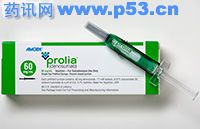制造商:
安进公司
药理分类:
破骨细胞抑制因子(RANKL的抑制剂)
活性成分(补):
denosumab的60mg/mL;溶液为SC损伤;不含防腐剂。
指示(补):
在绝经后妇女骨质疏松症:在高风险骨折作为骨质疏松性骨折,骨折或多种危险因素的历史定义,或者谁失败或不能耐受其他治疗的患者,以减少脊椎,非脊椎发生率,以及髋部骨折。
药理作用:
Denosumab是一个人的血清IgG2单克隆抗体结合的核因子kappa - B的配体(RANKL的)人类受体激活剂。 denosumab的防止及其受体的相互作用及其对破骨细胞前体,从而抑制破骨细胞的形成,功能和生存的表面RANKL的。这反过来又减少中皮质和骨小梁骨吸收,增加骨量和强度。
临床试验:
中的安全性和治疗绝经后骨质疏松denosumab的疗效进行了评估,3年在任的腰椎或髋关节,随机研究,涉及7808妇女骨密度的T - -2.5和-4.0之间得分60-91岁。所有受试者每天补充钙和维生素D,除了研究药物或安慰剂,每6个月内给予。主要效果变数是新的脊椎骨折的发生率在3年;次要疗效变量的髋关节和非脊椎骨折的发生率。
denosumab的显着地降低一新的脊椎骨折的发生率,2和3年。在3年,发生率7.2相比,2.3试验药物组(相对危险降低68%)%,安慰剂组%。在三年级时,髋部骨折的发生率1.2%,安慰剂组相比,0.7 denosumab的(相对危险减少40%)%。非脊椎骨折的妇女在与第3年的比例为8.0%,安慰剂组相比,6.5 denosumab的(相对危险减少20%)%。
与denosumab的处理明显增加,在3年(腰椎,髋关节,股骨颈)测量所有站点骨质密度(BMD)。 denosumab的停药后,骨密度恢复到基线水平在1年。
法律分类:
接收
成人:
应管理的医疗保健专业人士。资深大律师60毫克每6个月;注入上臂,大腿或腹部。
儿童:
不推荐。
禁忌(补):
低钙血症。
警告/注意事项:
正确的开始之前低钙血症;确保有足够的每日钙(≥1000毫克)和Vit.D(≥400IU)的摄入量,尤其。在肾功能损害(肌酐清除率<30mL/min)。监视器钙,磷,在(甲状旁腺功能低下,甲状腺或甲状旁腺手术,吸收不良,严重肾透析减值)易感病人镁的水平。监控感染,颚骨坏死,骨oversuppression。做基线口试和预防牙科颌骨骨坏死的风险,如果存在(例如,拔牙,牙种植体,口腔外科,肿瘤,贫血,凝血功能障碍)。保持良好的口腔卫生。免疫功能低下。乳胶过敏(预充式注射器)。妊娠(Cat.C)。哺乳母亲:避免(可能损害/哺乳期乳腺增生病)。
互动(补):
伴随免疫抑制剂(增加感染的风险)。皮质类固醇(颚骨坏死的风险增加)。
不良反应(补):
疼痛(背部,下肢或肌肉骨骼),高胆固醇血症,膀胱炎,感染(可能是严重的,例如,蜂窝组织炎,泌尿道感染,耳,腹部),皮炎,皮疹,湿疹,颚骨坏死,骨营业额,低钙血症加重镇压,胰腺炎。
如何提供:
单用小瓶(1毫升)-1
单剂量预充锡尔河(1毫升)-1
最后更新:
2010年6月17号
PROLIA
Manufacturer:
Amgen, Inc.
Pharmacological Class:
Osteoclast inhibitor (RANKL inhibitor)
Active Ingredient(s):
Denosumab 60mg/mL; soln for SC inj; preservative-free.
Indication(s):
In postmenopausal women with osteoporosis: at high risk for fracture, defined as a history of osteoporotic fracture, or multiple risk factors for fracture; or patients who have failed or are intolerant to other therapy; to reduce incidence of vertebral, nonvertebral, and hip fractures.
Pharmacology:
Denosumab is a human IgG2 monoclonal antibody that binds to human receptor activator of nuclear factor kappa-B ligand (RANKL). Denosumab prevents RANKL from interacting with its receptors on the surfaces of osteoclasts and their precursors, thereby inhibiting osteoclast formation, function, and survival. This in turn decreases bone resorption and increases bone mass and strength in both cortical and trabecular bone.
Clinical Trials:
The safety and efficacy of denosumab in the treatment of postmenopausal osteoporosis was assessed in a 3-year, randomized study involving 7808 women 60–91 years of age with BMD T-score between –2.5 and –4.0 at either the lumbar spine or total hip. All subjects were supplemented with daily calcium and vitamin D, in addition to the study drug or placebo given once every 6 months. The primary efficacy variable was the incidence of new vertebral fractures at 3 years; secondary efficacy variables were the incidences of hip and nonvertebral fractures.
Denosumab significantly reduced the incidence of new vertebral fractures at 1, 2, and 3 years. At 3 years, the incidence was 7.2% in the placebo group compared to 2.3% in the study drug group (relative risk reduction 68%). At year 3, the incidence of hip fracture was 1.2% for placebo compared to 0.7% for denosumab (relative risk reduction 40%). The proportion of women with nonvertebral fracture at year 3 was 8.0% for placebo compared to 6.5% for denosumab (relative risk reduction 20%).
Treatment with denosumab significantly increased bone mineral density (BMD) at all sites measured at 3 years (lumbar spine, total hip, femoral neck). After discontinuation of denosumab, BMD returned to baseline levels within 1 year.
Legal Classification:
Rx
Adults:
Should be administered by a healthcare professional. 60mg SC once every 6 months; inject into upper arm, upper thigh, or abdomen.
Children:
Not recommended.
Contraindication(s):
Hypocalcemia.
Warnings/Precautions:
Correct hypocalcemia before starting; ensure adequate daily calcium (≥1000mg) and Vit.D (≥400IU) intake, esp. in renal impairment (CrCl<30mL/min). Monitor calcium, phosphorus, magnesium levels in susceptible patients (hypoparathyroidism, thyroid or parathyroid surgery, malabsorption, severe renal impairment, on dialysis). Monitor for infections, jaw osteonecrosis, bone oversuppression. Do baseline oral exam and preventive dentistry if risks for jaw osteonecrosis exist (eg, tooth extraction, dental implants, oral surgery, cancer, anemia, coagulopathy). Maintain good oral hygiene. Immunosuppressed. Latex allergy (prefilled syringe). Pregnancy (Cat.C). Nursing mothers: avoid (may impair mammary glands/lactation).
Interaction(s):
Concomitant immunosuppressants (increased infection risk). Corticosteroids (increased jaw osteonecrosis risk).
Adverse Reaction(s):
Pain (back, lower extremities or musculoskeletal), hypercholesterolemia, cystitis; infections (may be serious; eg, cellulitis, UTI, otic, abdominal), dermatitis, rash, eczema, osteonecrosis of jaw, suppression of bone turnover, exacerbation of hypocalcemia, pancreatitis.
How Supplied:
Single-use vial (1mL)—1
Single-dose prefilled syr (1mL)—1


